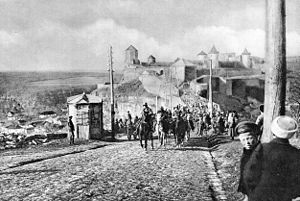| Operation Faustschlag | |||||||||
|---|---|---|---|---|---|---|---|---|---|
| Part of the Eastern Front of World War I | |||||||||
 Austro-Hungarian troops enter Kamianets-Podilskyi, Western Ukraine with the city's iconic castle in the background | |||||||||
| |||||||||
| Belligerents | |||||||||
| Commanders and leaders | |||||||||
|
|
| ||||||||
| Units involved | |||||||||
|
| |||||||||
| Strength | |||||||||
| 53 divisions | Unknown | ||||||||
| Casualties and losses | |||||||||
| Unknown |
63,000 captured 2,600 guns and 5,000 machine guns[1] | ||||||||
The Operation Faustschlag ("Operation Fist Punch"), also known as the Eleven Days' War,[2][3] was a Central Powers offensive in World War I. It was the last major offensive on the Eastern Front.
Russian forces were unable to put up any serious resistance due to the turmoil of the Russian Revolution and subsequent Russian Civil War. The armies of the Central Powers therefore captured huge territories in Estonia, Latvia, Belarus, and Ukraine, forcing the Bolshevik government of Russia to sign the Treaty of Brest-Litovsk.
- ^ Gilbert 2023, p. 540.
- ^ Mawdsley 2007, p. 35.
- ^ "Lenin's speech at Extraordinary Seventh Congress of the RSDLP(B) 6th March 1918 about Political Report of the Central Committee". Retrieved 6 May 2020.